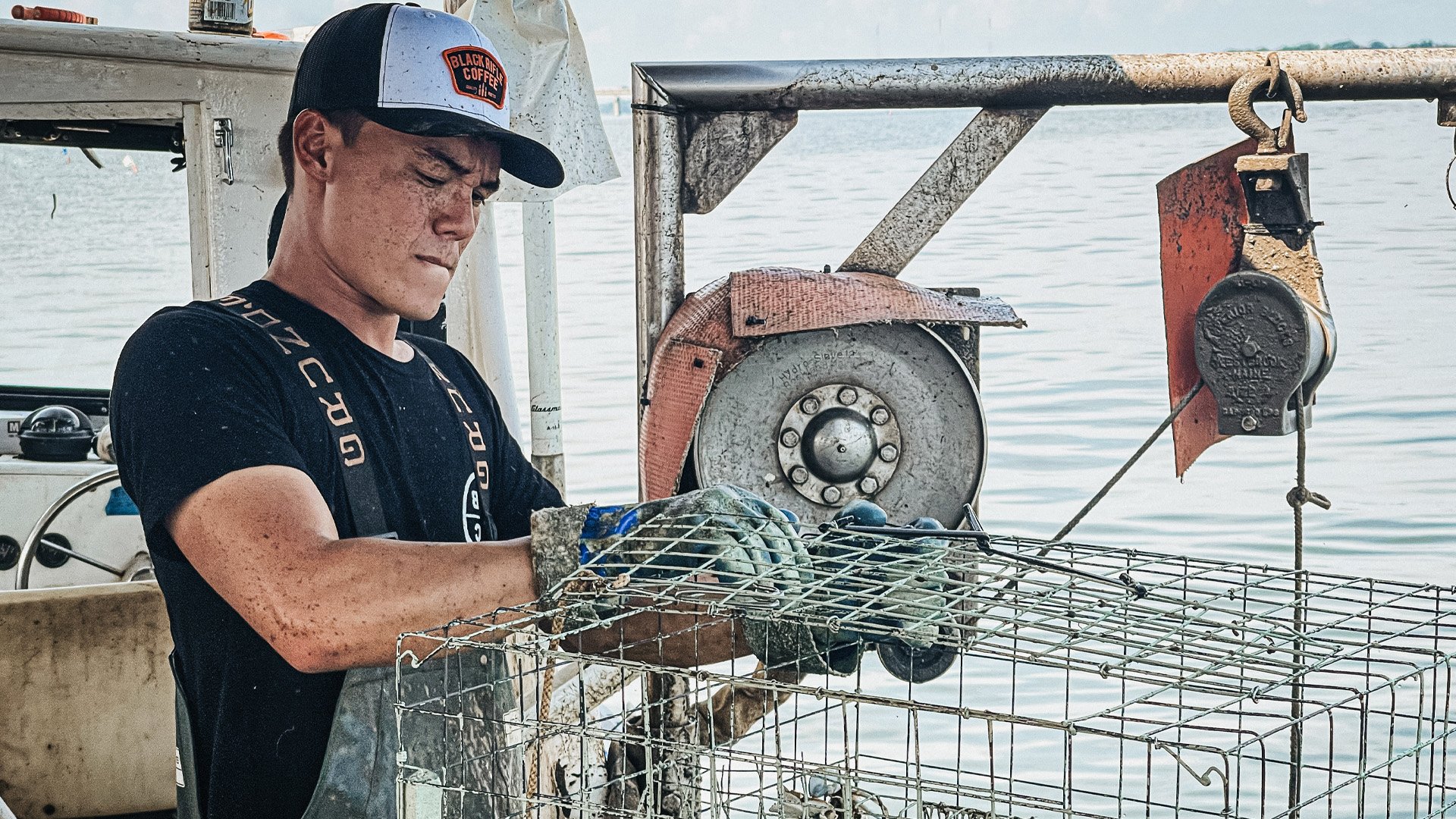
Known as "Captain TikTok," Luke McFadden can now count himself among the watermen whose pictures he grew up admiring. Photo by Mac Caltrider/Free Range American.
This article was originally published on July 20, 2023, on Free Range American.
It’s 5 a.m. when Luke McFadden pulls into the gravel parking lot of the Locust Point Marina. He grabs a small cooler of water from the bed of his white pickup and walks the few steps to the stern of F.V. Southern Girl — his 34-foot fiberglass crabbing boat.
The predawn darkness obscures his youthful face, peppered with freckles. At 27, McFadden is one of the youngest commercial crabbers on the Chesapeake Bay. Yet, despite being comparatively green, he’s managed to carve out a spot in the Bay’s close-knit crabbing fleet.
“I’ve got an extra pair of rubber boots for you,” he tells me in a thick Delmarva accent.
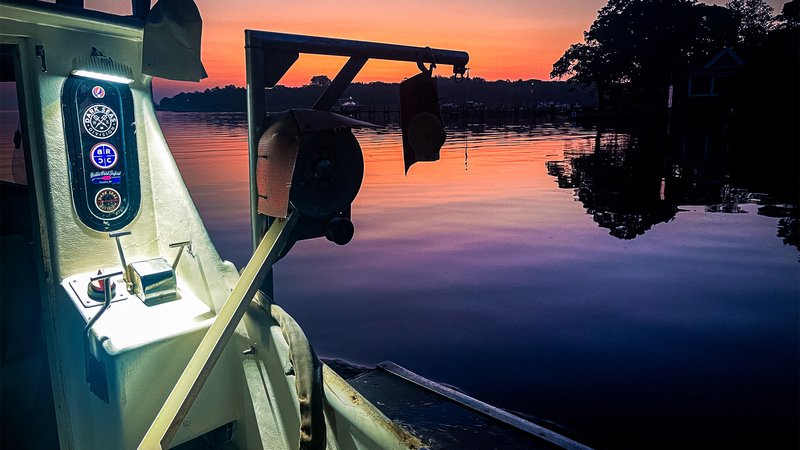
The F.V. Southern Girl makes its way out of Bodkin Creek. Photo by Mac Caltrider/Free Range American.
I don the waterproof footwear while McFadden and two other crabbers go about prepping the Southern Girl for another day on the Chesapeake. Working by the light of their headlamps, they top off the fuel, load the day’s bait of crawfish and menhaden, and untie the mooring lines. With the boat untethered from the dock, McFadden steers us out of Bodkin Creek and onto the wide-open water of the Bay.
He’s what people in the region call a self-made waterman — a term applied to commercial fishermen and crabbers. He grew up near the water in Pasadena, Maryland, but unlike most of his peers, he doesn’t come from a family of watermen. Oddly enough, McFadden’s introduction to this centuries-old crabbing industry came from a coffee table book his grandmother had.
He used to spend hours staring at the black-and-white photographs in its pages of Chesapeake watermen hauling oysters and crabs from the Bay’s 18 trillion gallons of brackish water. McFadden knew in the fifth grade he would be a waterman one day.
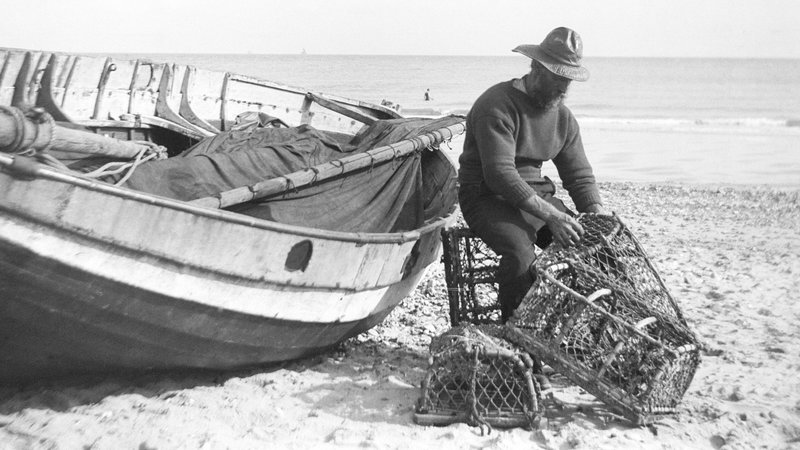
A waterman mending his crab pots in 1910. Wikimedia Commons photo.
In his elementary school yearbook, where other kids wrote things like astronaut and firefighter for what they aspired to be when they grew up, McFadden wrote, “Crabber.”
He paid his dues, coming up on other crabbing boats and learning the ropes as a hired hand. But that’s not what makes him stand out from the rest of the fleet. McFadden has found a way to become the most famous waterman on the Chesapeake.
Related: The Legend of Jack Hemingway: OSS Commando, Fly Fisherman, POW, Writer
Luke McFadden: Industry Outsider
Since setting his first crab pots nine years ago, McFadden has risen from industry outsider to internet phenomenon. Known by some as “Captain TikTok,” he’s wrangled 1.6 million followers on TikTok and 180,000 on Instagram.
His live streams regularly attract more than 1 million viewers. By leveraging social media, McFadden has made a name for himself. While he once struggled to sell the crabs he caught, McFadden now has no problem selling out. The demand for his crabs is so high that a local seafood restaurant has started to ship them anywhere in the country.

Customers and fellow crabbers still call Luke McFadden “Captain TikTok.” Photo by Mac Caltrider/Free Range American.
While the notoriety has helped McFadden grow his business, it doesn’t always sit well with some of the fleet’s old-timers.
“The average license holder is about 56 and comes from a watermen family, so I’m an outlier in the industry by a fucking long shot,” he says while steering the boat south toward the 4-mile-long Chesapeake Bay Bridge. “I’ve had people mess with my pots and write racial slurs on my floats. It’s sort of the Wild West out here.”
Not only is McFadden 30 years younger than most watermen, he also looks different. He’s of half-Korean, half-Irish descent, and some watermen have made it clear they don’t think he belongs. Some even smashed McFadden’s sign and dumped dead fish on the lot where he sells his crabs.
“He’s the only brown crabber,” jokes Matt Boyle, one of the other two crabbers on the boat.

The young Luke McFadden says he still faces occasional discrimination from other watermen. Photo by Mac Caltrider/Free Range American
Although it doesn’t happen as much as when he got started, his equipment has been vandalized as recently as last season. But McFadden is too busy crabbing to let a few racists bully him out of the industry. He uses their attempts to chase him away as fuel.
Related: The Inside Story of an SBS Veteran who Rowed Across the Atlantic
All in a Day’s Work
The F.V. Southern Girl, whose cramped deck is loaded with boxes of bait, extra lines, and a finicky water heater, is down a man today. One member of the four-man crew drank too much the night before and was a no-show at the marina. After a few minutes of waiting around and having calls sent straight to voicemail, McFadden decided to go out without him. Time is money in crabbing, and McFadden can’t afford to wait around at the dock.
The plan is to pull 500 pots before noon. McFadden set 20 lines of 25 crab pots yesterday, and each one should now be crawling with blue crabs.
Each pot is a 20-inch cubical trap of galvanized mesh with a bottom framed in rebar. The pots are attached to a line with a buoy, or “float,” marking their locations. Hauling 20 lines of heavy pots is no leisurely task.

The crew doesn’t stop just because they are short-handed; Luke McFadden and the others just step it up. Photo by Mac Caltrider/Free Range American.
McFadden pilots the boat to each float, pulling each pot from the bottom of the Bay and hoisting them aboard using a pulley. The next man in the assembly line empties the pot of angry, pinching blue crabs, then rebaits the trap. The pot then goes to the next man, who sanitizes it in a tub of scalding water and stacks it along the port gunwale.
The last man sorts through the crabs — measuring, squeezing, and ultimately deciding which ones are worthy of keeping. Any crab deemed low quality gets tossed back in the brine. Finally, the whole process is reversed as each line of 25 pots gets redeployed overboard to catch more crabs. McFadden and his crew repeat this process 19 more times, then do it all again the next day.
Each pot that’s full of crabs is also full of jellyfish. The gelatinous creatures emerge from the water tangled in the mesh-like dead soldiers snared in barbed wire. While each member of the assembly line does their best to knock the painful nettles off the pot, getting stung is inevitable.

No one escapes without jellyfish stings. Every pot is riddled with their tentacles. Photo by Mac Caltrider/Free Range American.
By the second line of pots, everyone’s arms are fire-truck red, with bumps and lines left by severed tentacles. The strenuous work is all done in cramped, slippery quarters under the continuous onslaught of oppressive July heat.
McFadden doesn’t mind the hard work. Crabbing on the largest estuary in the United States has been his lifelong dream, and he’s just grateful to finally make a living.
“My first boat was named The Widow. It was literally just a hull with a transom for a small motor — a real piece of shit. I called it The Widowmaker,” he says as he pilots the Southern Girl through mild chop.
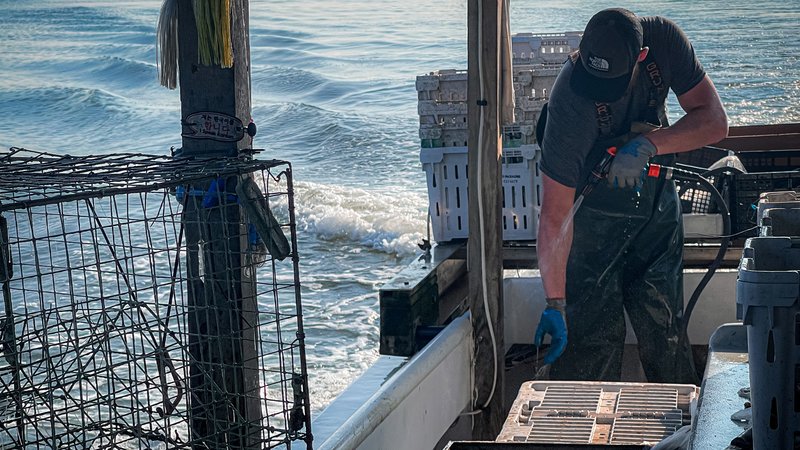
Matt Boyle tries to wash jellyfish stings off his arm. Photo by Mac Caltrider/Free Range American.
McFadden worked odd jobs for a year just to afford The Widowmaker. Any money he saved went straight into the boat. He built its floor and cabin, updating parts until it was finally seaworthy. He says the first few years crabbing on that boat were terrible.
“I’d make just enough money to afford to go back out the next day,” he says. “I probably should have stopped, but I’m just too dumb to quit.”
After a rough start, McFadden began to save a little money. Then, in 2017, he got stuck in a storm that cracked his boat’s hull. It cost him everything he had to start over.
“That was like a crossroads. I had to decide if I was going to put all my eggs in this basket, but I’m a firm believer that if you really want something, you will find a way to make it happen.”
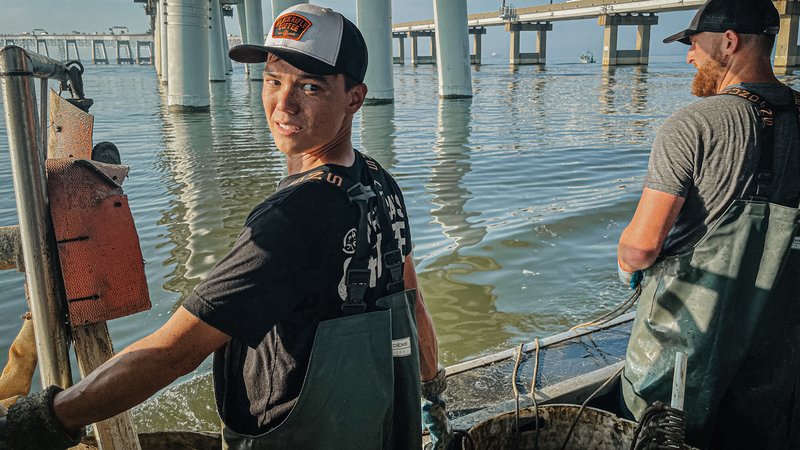
Many blue crabs call the water beneath the Chesapeake Bay Bridge home, and Luke McFadden is coming after them. Photo by Mac Caltrider/Free Range American.
McFadden scrounged every cent to his name and bought the F.V. Southern Girl. The fiberglass crab boat came outfitted with the bigger diesel engine that’s now carrying us from line to line.
The three crabbers’ enthusiasm for their work is infectious. After a couple of hours of being little more than a bystander with a camera, I offer to fill the spot of the missing fourth man. McFadden enthusiastically hands me a pair of rubber slickers and sticks me in the assembly line as the pot stacker.
I pull the pots from the hot water tub, stack them three high, and line them along the gunwale. It only takes one line of pots before I’m intimately familiar with the dull sting of jellyfish tentacles.

The Chesapeake Bay is home to the largest blue crab fishery in the world. Photo by Mac Caltrider/Free Range American.
The season’s abnormally warm weather has flooded the Bay with more of the little bastards than usual, but the stinging critters have been a part of crabbing here for a long time. Locals have been dueling with them since before the 1600s when Algonquin tribes in the region first relied on blue crabs as an important food source.
Blue crabs — whose scientific name Callinectes sapidus translates to “beautiful swimmers” — didn’t become a popular food for English settlers until the 1700s. Even then, harvesting crabs was done through individual trotlines, which kept crabs a strictly regional delicacy.
Then, in 1928, a Virginia crabber named Benjamin Lewis invented the modern crab pot, vastly improving the efficiency of crabbing. Allowing watermen to catch crabs by the bushel allowed the taste for the 10-legged crustaceans to grow beyond the Chesapeake watershed.

Without modern crab pots, watermen like Luke McFadden would have to harvest crabs with a trout line. Photo by Mac Caltrider/Free Range American.
For the first few hours of work, a radio in the Southern Girl’s two-person cabin plays cookie-cutter pop-country songs. The music shifts to classic rock as the sun rises in the sky and the work gets harder. AC/DC and Zeppelin provide the soundtrack when conversation gives way to fatigue. Then, sometime around lines 16 and 17, the music changes again. The sounds of Slipknot bounce off the boat’s hardtop.
While hauling in the 18th line of pots, McFadden pauses to show me a female blue crab with a “sponge” attached to her abdomen. The sponge is covered in about 2 million orange eggs. The same warm water that brings an abundance of jellies also makes for ideal crab mating conditions.
“Crabs are finicky critters, man,” says McFadden. “Water temperature, PH levels, salinity — everything’s got to be perfect for them.”
McFadden views crabbing as an art form. To catch crabs, one has to think like a crab. He places his pots where he estimates the crabs will be tomorrow. Some days he nails it — hauling in up to 40 bushels of the beautiful swimmers — other days, he’s not so fortunate.
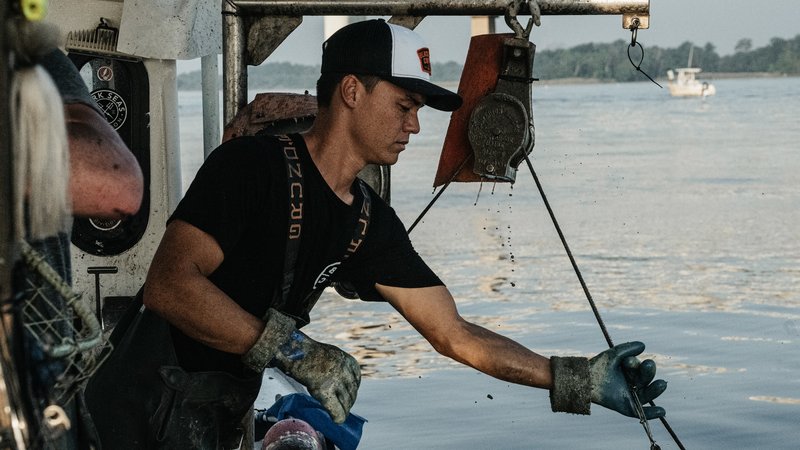
Luke McFadden pulls 500 crab pots nearly every day. Photo by Mac Caltrider/Free Range American.
As I realize that today is one of those less-fortunate days, the Slipknot on the radio gives way to vintage Limp Bizkit. “It’s just one of those days…everything is fucked, everybody sucks,” blares from the cabin speakers as we pull alongside the last line of pots.
After we bring in the last crabs of the day, McFadden estimates the haul to be about seven bushels. He could have ended the day with more, but McFadden is strict about keeping only high-quality crabs. Every crab he catches gets measured and squeezed. An experienced hand can tell how full of meat they are by squeezing specific parts of the crustaceans.
“If you go farther south, they’re a little less worried about quality,” he says. “Down there, a crab is a crab is a crab. Up here, the market demands we only sell the best of the best.”
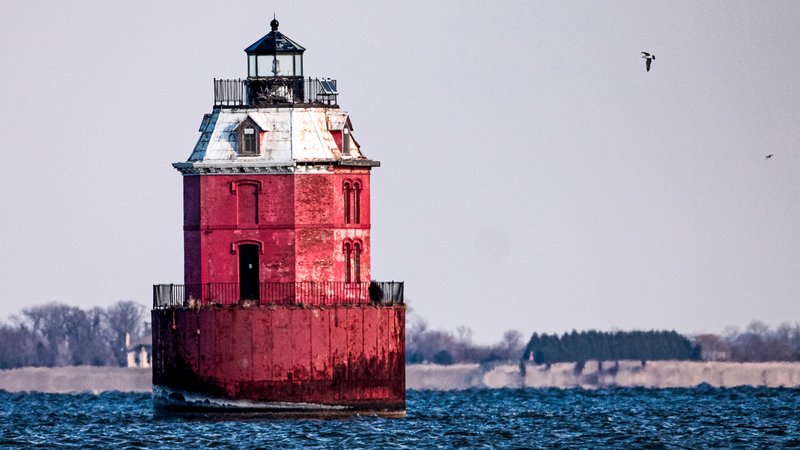
The Sandy Point Lighthouse was erected in 1883. Today it marks a prime crabbing location. Wikimedia Commons photo.
We head back to the marina with what McFadden says is one of his worst hauls of the year. Despite the day’s lackluster catch, he seems undaunted. He knows that, like the Chesapeake Bay itself, there is an ebb and flow in commercial crabbing and that consistency is the key to success. He goes out each morning regardless of whether he filled his boat the day before or caught barely a dozen crabs.
Related: Heroism in the Deep: The 1939 Rescue of the USS Squalus
Luke McFadden and the American Dream
It’s common to hear locals complain about the rising price of their favorite food. A dozen large crabs currently cost about $100 — a bushel runs closer to $500. But McFadden is quick to point out how expensive it is for watermen just to get on the water and pursue the evasive crustaceans.
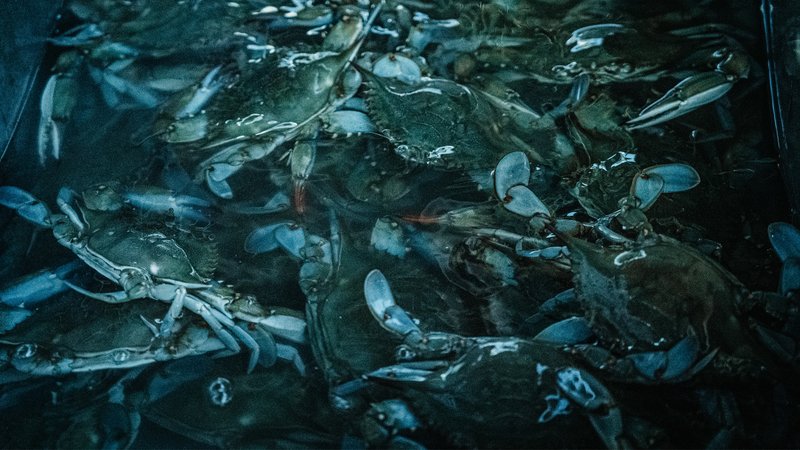
Seven bushels is a slow day for the F.V. Southern Girl. Photo by Mac Caltrider/Free Range American.
Between fuel and equipment expenses, it costs $15,000 before he ever puts the season’s first crab pot in the water, he says. Broken down to daily expenses, he estimates that it costs more than $900 to leave the dock in the morning. But at a time when Americans are paying closer attention to where their food comes from, McFadden has found a way to compensate for the steep cost by selling directly to customers.
Instead of moving his catch through a restaurant (which would take a cut for themselves), McFadden leverages social media to help skip the middleman. He live-streams catching the crabs, so consumers can literally watch their food get plucked right out of the Bay. A few hours later, they can buy those same crabs to eat for dinner.
“I’m the only crab guy on the internet,” he says. “My theory for success is to be the biggest fish in the smallest pond.”
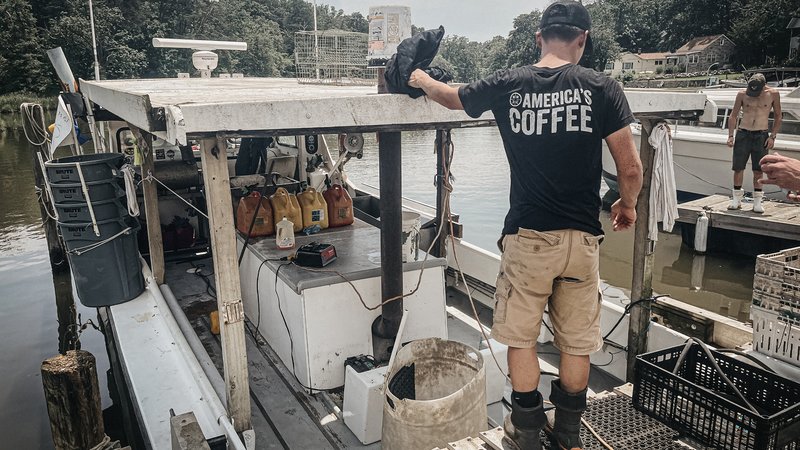
Harvesting the crabs is only the first half of Luke McFadden’s workday. Photo by Mac Caltrider/Free Range American.
As I drive home to wash the jelly stings off my arms, Luke McFadden sets off to begin the second half of his workday — selling the day’s catch. All commercial crabbers work their asses off, but few are putting in the extra hours quite like the captain of the F.V. Southern Girl does.
After just one day aboard his boat, I’ve come to admire the man. Not because he was welcoming or because he catches one of my favorite foods — both are true — but because he embodies the values that make our country great.
With no familial connection and no experience, he’s managed to pave his own way into an otherwise unwelcoming industry. He’s made a name for himself through hard work and creativity alone. The work might be dirty and smell like dead marine life, but Luke McFadden is living the American dream.
Each year brings with it new regulations and restrictions on how many crabs watermen can harvest. But so long as there are crabs to be caught, McFadden will continue taking his boat out on the predawn Bay to hunt for the beautiful blue swimmers.
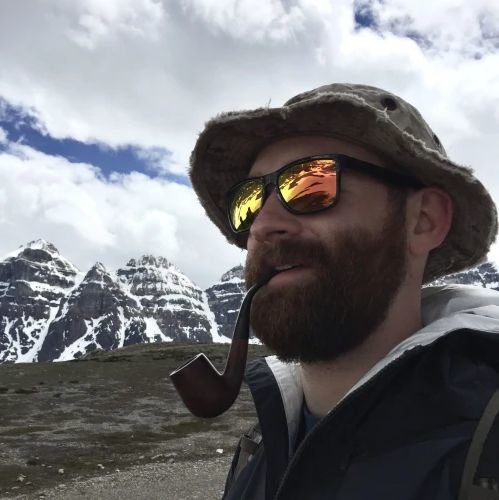
Mac Caltrider is a senior staff writer for Coffee or Die Magazine. He served in the US Marine Corps and is a former police officer. Caltrider earned his bachelor’s degree in history and now reads anything he can get his hands on. He is also the creator of Pipes & Pages, a site intended to increase readership among enlisted troops. Caltrider spends most of his time reading, writing, and waging a one-man war against premature hair loss.
BRCC and Bad Moon Print Press team up for an exclusive, limited-edition T-shirt design!
BRCC partners with Team Room Design for an exclusive T-shirt release!
Thirty Seconds Out has partnered with BRCC for an exclusive shirt design invoking the God of Winter.
Lucas O'Hara of Grizzly Forge has teamed up with BRCC for a badass, exclusive Shirt Club T-shirt design featuring his most popular knife and tiomahawk.
Coffee or Die sits down with one of the graphic designers behind Black Rifle Coffee's signature look and vibe.
Biden will award the Medal of Honor to a Vietnam War Army helicopter pilot who risked his life to save a reconnaissance team from almost certain death.
Ever wonder how much Jack Mandaville would f*ck sh*t up if he went back in time? The American Revolution didn't even see him coming.
A nearly 200-year-old West Point time capsule that at first appeared to yield little more than dust contains hidden treasure, the US Military Academy said.












